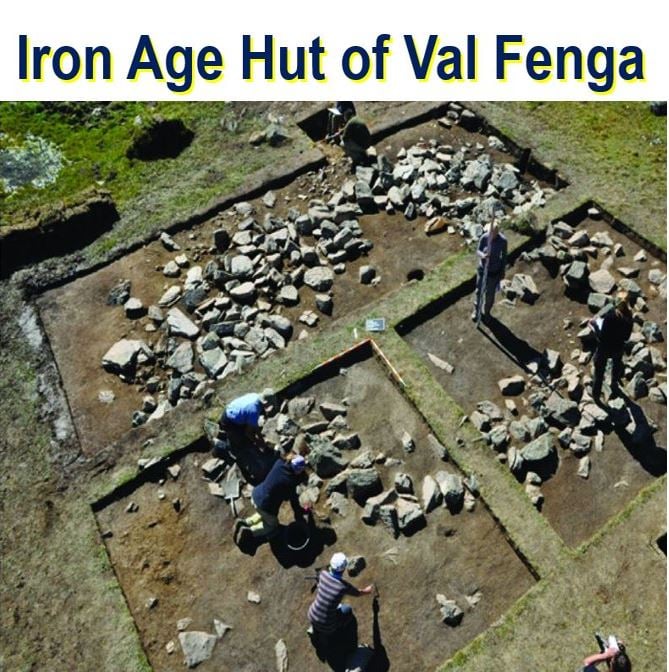Swiss cheese has been around for a very long time – scientists say Alpine cheese-making dates back to the first millennium BC, i.e. the Iron Age. Cheese-making at high altitudes in the Alps during prehistoric times paved the way for such modern delicacies as Emmental and Gruyere, said researchers from the Universities of York and Newcastle in England, as well as colleagues from Switzerland and Brazil.
The international team explained in the scientific journal PLUS ONE (citation below) that they looked at residue compositions left on fragments of ceramic pots found at six different sites in the Swiss Alps. The shards of pottery were dated from Neolithic times (later part of Stone Age) to the Iron Age.
Dr. Kevin Walsh, Senior Lecturer in the University of York’s Department of Archaeology, and colleagues found that the residue on those from the Iron Age – 1st millennium BC – had the same chemical signatures associated with the heating milk from sheep, cows and goats, as part of the cheese-making process.
 The Iron Age Hut of Val Fenga, where several pots were unearthed, during excavation. (Image: PLOS ONE)
The Iron Age Hut of Val Fenga, where several pots were unearthed, during excavation. (Image: PLOS ONE)
Scientists examined prehistoric pots
The ceramic fragments that the scientists examined had been discovered in the ruins of ancient stone buildings similar to those used by alpine dairy farmers today to make cheese during the summer months.
Previous studies have shown that cheese was produced a very long time ago in lowland settings. However, no evidence has ever been found regarding cheese-making during pre-history at high altitude, that is, until now.
The authors say that the emergency of alpine dairying occurred about the same time as the population increased and arable farming grew in the lowlands. The resulting pressure on valley pastures forced herdsmen to move up the mountains.
Dr. Walsh said:
“The principal interest of this piece of work is that it provides direct evidence for early dairying at high altitude in the Alps. Until now, we have been reliant on indirect evidence for pastoralism and dairying in the Alps, changes in vegetation and archaeological structures that suggest pastoral practices.”
“This piece of work exemplifies successful collaboration between field archaeologists and science-based archaeologists across an international network.”
 Location, dates and altitudes of the earliest upland dry-stone structures in the Alps. (Image: PLOS ONE)
Location, dates and altitudes of the earliest upland dry-stone structures in the Alps. (Image: PLOS ONE)
Prehistoric cheese-makers faced hostile conditions
Dr. Francesco Carrer, Research Associate at Newcastle University’s School of History, Classics and Archaeology, said:
“Even today, producing cheese in a high mountainous environment requires extraordinary effort. Prehistoric herders would have had to have detailed knowledge of the location of alpine pastures, be able to cope with unpredictable weather and have the technological knowledge to transform milk into a nutritious and storable product.”
“We can now put alpine cheese production into the bigger picture of what was happening at lower levels. But there is more work needed to fully understand the prehistoric alpine cheese-making process such as whether the cheese was made using a single milk or a blend and how long it was matured for.”
Alpine dairying is a massive, multi-billion dollar industry today, and an important source of jobs in parts of Switzerland, Italy and France. It also a major part of cultural tradition in those regions.
Alpine cheeses such as Gruyere, Emmental and Raclette are globally renowned because of centuries-old recipes and the traditional methods used in their production.
 According to Cheese from Switzerland: “Swiss Alpine cheese does not refer to a single uniform product, but to a whole range of regional Alpine cheese specialities. Each Alpine cheese has at least as much individual character as the Alpine cheesemaker that produces it.” (Image: cheesesfromswitzerland.com)
According to Cheese from Switzerland: “Swiss Alpine cheese does not refer to a single uniform product, but to a whole range of regional Alpine cheese specialities. Each Alpine cheese has at least as much individual character as the Alpine cheesemaker that produces it.” (Image: cheesesfromswitzerland.com)
In an Abstract in the journal, the authors wrote:
“Dairy production in such a marginal environment [high up in the Alps] implies a high degree of risk even by today’s standards.”
“We postulate that this practice was driven by population increase and climate deterioration that put pressure on lowland agropastoral systems and the establishment of more extensive trade networks, leading to greater demand for highly nutritious and transportable dairy products.”
Citation: “Chemical Analysis of Pottery Demonstrates Prehistoric Origin for High-Altitude Alpine Dairying,” Francesco Carrer, André Carlo Colonese, Alexandre Lucquin, Eduardo Petersen Guedes, Oliver E. Craig, Anu Thompson, Oliver E. Craig, Kevin Walsh & Thomas Reitmaier. PLUS ONE. Published 21 April, 2016. DOI: 10.1371/journal.pone.0151442.
Video – Alpine cheese-making
Alpine cheese-making, which is rooted in survival, is an industry that has existed in the Alps for thousands of years.
